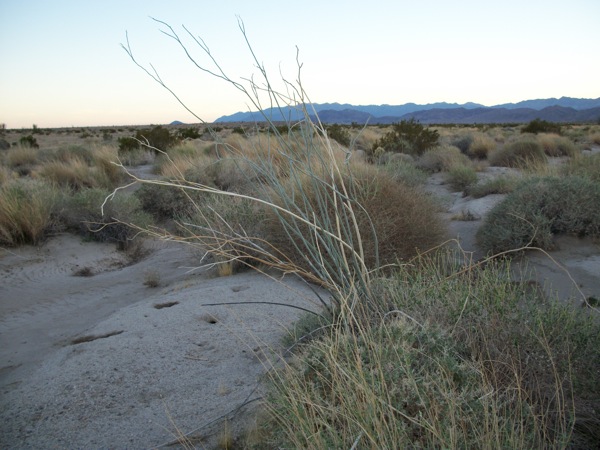AES Wants to Push Project Forward
March 2, 2011 - Bob Hemple, CEO of AES, says his company was delighted to be in the Imperial Valley, and they planned to move forward with the Imperial Valley Solar Project. He said AES was probably the largest electric utility nobody ever heard of: the company had $40 billion is assets, with investment projects across the United States and throughout the world. He said the plan is to meet with the stakeholders in Imperial Valley solar, including elected officials, tribal leaders, BLM and others. The project would be redesigned to a more traditional project and permits would be amended. He said they plan to move quickly and as respectfully as possible.
http://kxoradio.com/news/local/703-aes-anxious-to-move-forward.html
Tessera Sells Project to AES
February 17, 2011 - Imperial Valley, California. Tessera announced that its 709-MW Stirling dish project was sold to AES Solar, a joint venture of Riverstone which was founded in 2000 by Pierre F. Lapeyre, Jr. and David M. Leuschen, who had been instrumental in the formation of the Goldman Sachs Global Energy & Power Group. Riverstone is a joint venture and the public face of the Carlyle Group, which has included such investors as former President George H. W. Bush and former British Prime Minister John Major.
AES Solar said in a press release that it intends to fulfill the contract with SDG&E. But Patty Rollin, a managing director of AES Solar, declined to provide details about the purchase or development plans for the project.
AES specielizes in photovoltaic systems, thus we speculate that the project will be switched over to this technology. The company would not comment on whether it would use polycrystalline or thin-film photovoltaic.
http://www.signonsandiego.com/news/2011/feb/16/irish-congolmerate-sells-imperial-valley-solar-pro/
Quechan Tribe to Go For Permanent Injunction
February 3, 2011 - “We're not against (the project), but please don't destroy our history. Our ancestors are buried there. There are many sacred sites there. It would be impossible to work around them.” -- Quechan Tribal President Mike Jackson Sr.
The Quechan Indian Tribe is preparing to take its fight against the proposed Imperial Valley Solar Project to Washington, D.C., with plans to file a motion for summary judgment. The Tribe won a temporary injunction in December, but wants to win a permanent injunction.
Tessera Solar spokeswoman Janette Coates said that the company “expects to have ongoing discussions with the tribe and we are optimistic that we will come to a solution that allows us to bring clean, renewable power to the Imperial Valley and San Diego.”
Last week, a meeting was held in the Quechan Tribal Chambers with representatives of the Department of Interior, Bureau of Land Management and Tessera. The Early Neutral Evaluation Conference was court-ordered to see if a compromise could be reached among the parties.
“We told them there would be no compromise,” said Jackson, who contends that the tribe wasn't consulted in advance about the project, as required by federal law. “They should have talked to us a couple of years ago. Our concern isn't with Tessera but with Salazar. We'll fight our battle in D.C.”
Department of Interior violated the California Desert Conservation Area Land Management Plan, the Tribe said, as well as the Federal Land Policy and Management Act, National Historic Preservation Act and the National Environmental Policy Act.
http://www.yumasun.com/news/tribe-67266-project-solar.html
Lawsuit Against Imperial Valley Solar Project
January 21, 2011 - A suit was filed by the Protect Our Communities Foundation, Backcountry Against Dumps and the East County Community Action Coalition, as well as Boulevard activist Donna Tisdale, naming the Department of Interior and the Bureau of Land Management, as well as their leaders, Ken Salazar and Robert Abbey, as defendants.
This is the third lawsuit in San Diego federal court seeking to block construction of the Imperial Valley Solar Project.
http://www.signonsandiego.com/news/2011/jan/21/third-lawsuit-filed-to-stop-desert-power-plant/
First Solar May Buy Tessera's Project Rights
December 23, 2010 - The largest US solar company, First Solar, may be negotiating with Tessera Energy for its Imperial Valley project, according to Reuters. Environmental review would have to restart, as Tessera was proposing Stirling dish/engine technology, while First Solar is a photovoltaic thin-film panel maker.
In addition, any buyer for the Imperial Valley plant would have to resolve a conflict with the Quechan Indian tribe, on whose ancestral lands the plant would sit.
It is hard to say what Tessera's two projects would be worth. Last year, First Solar paid $400 million for OptiSolar's pipeline, which included a 550-megawatt plant under a power purchase agreement, plus a group of plants without power purchase agreements totaling 1,300 megawatts, and land rights to 136,000 acres. OptiSolar projects included the Stateline project in Ivanpah Valley.
http://www.reuters.com/article/idUSTRE6BM04Z20101223?pageNumber=2
Judge Grants Injunction - Win for Quechan Tribe
December 16, 2010 - United States District Judge Larry Burns ruled yesterday that the federal government failed to adequately consult the Quechan Tribe before approving the planned Imperial Valley Solar Project, which is slated for tribal lands in the Imperial Valley, California. Extensive consultation on the project is required by law.
The area where the project would be located has a history of extensive use by Native American groups. The parties agree 459 cultural resources have been identified within the project area. These include over 300 locations of prehistoric use or settlement, and ancient trails that traverse the site. The tribes in this area cremated their dead and buried the remains, so the area also appears to contain archaeological sites and human remains. The draft environmental impact statement (“EIS”) prepared by the BLM indicated the project "may wholly or partially destroy all archaeological sites on the surface of the project area.”
The Tribe argued the project would endanger the habitat of the flat-tailed horned lizard, which is under consideration for listing under the Endangered Species Act and which is culturally important to the Tribe. The Tribe maintains Defendants were required to comply with the National Environmental Policy Act (NEPA), the National Historical Preservation Act (NHPA), and the Federal Land Policy and Management Act of 1976 (FLPMA) by making certain analyses and taking certain factors into account deciding to go ahead with the project.
The Tribe maintains Bureau of Land Management didn’t adequately or meaningfully consult with them, but instead approved the project before completing the required consultation. According to the Tribe, BLM simply didn’t consider what the tribe had to say before approving the project. "The Court finds this to be the strongest basis for issuance of injunctive relief and therefore focuses on it."
The Tribe expressed concern that the schedule for issuance of the ROD didn’t allow enough time for adequate consultation, and that the required consultation was being inappropriate deferred.
"Government agencies are not free to glide over requirements imposed by Congressionally-approved statutes and duly adopted regulations," Judge Burns wrote in his order.
He further noted that the Department of the Interior, the key defendant in the tribe's suit, helped draft the requirements at issue. Congress and the DOI "could have made these consulting requirements less stringent, but they didn't," he wrote.
Burial areas and other significant landmarks are scattered across the proposed plant's site.
From Order from U.S. District Court (download >>here, 320 kb PDF), Southern California District; See story in Reuters.
Protest of Imperial Valley Solar Project
November 17, 2010 - Members of Desert Survivors, Basin and Range Watch, Solar Done Right, other environmentalists, the Quechan Tribe, Cocopah Tribe, Imperial Valley Environmental Justice Task Force, Comite Civico del Valle, Seeley Citizens United, and local residents from Imperial County, San Diego, and Mexico came to the three-day protest.
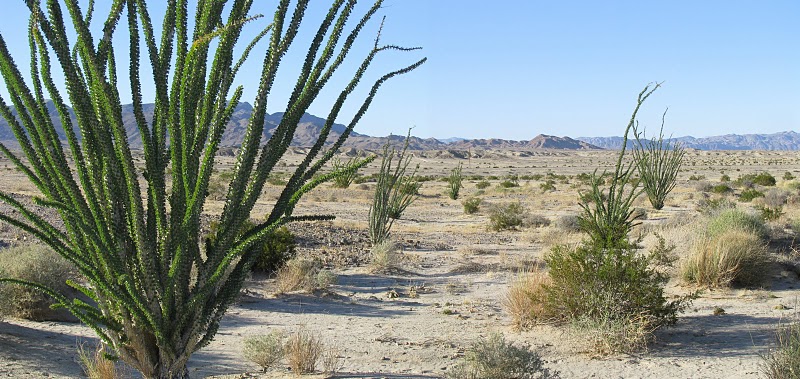
^Ocotillos on the project site (Photo by Tom Budlong).
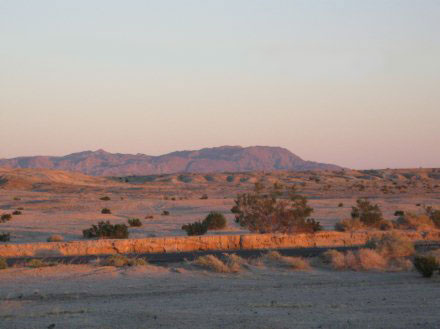
^Around 30,000 large 40-foot-tall Stirling dishes would be driven into the ground covering this landscape, denying the importance of the abundant cultural sites here.
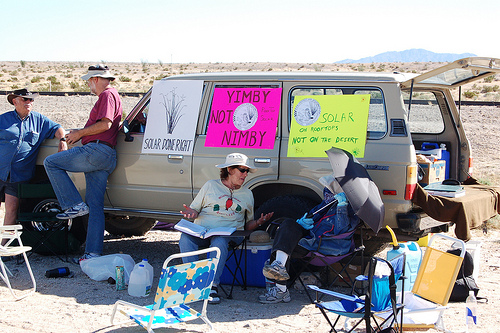
(Photo by Larry Hogue).

(Photo by Larry Hogue).
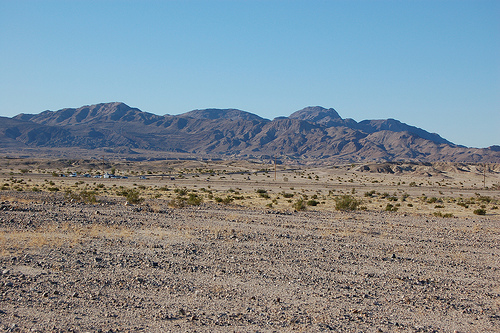
(Photo by Larry Hogue).

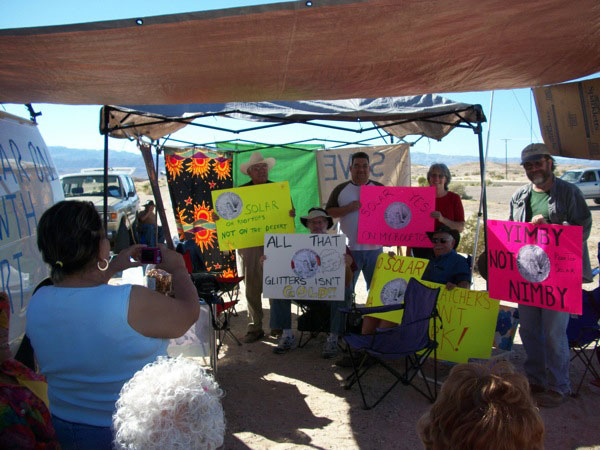
(Photo by Terry Weiner).
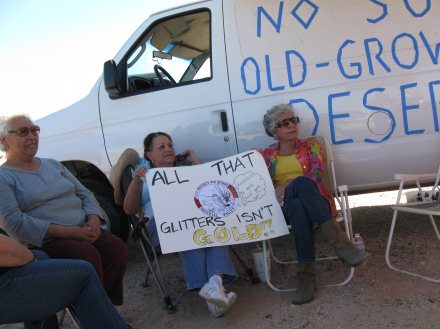

^The desert is full of life, including Burrwoing owls, Flat-tailed horned lizards, and rare wildflowers.
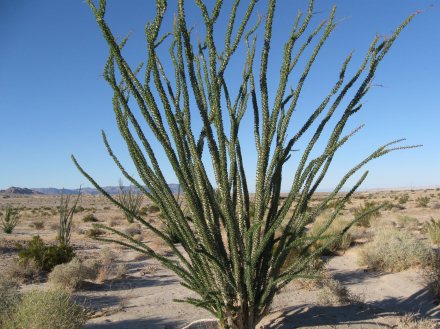
^Ocotillo in leaf and green after recent rains.

(Photo by Terry Weiner).
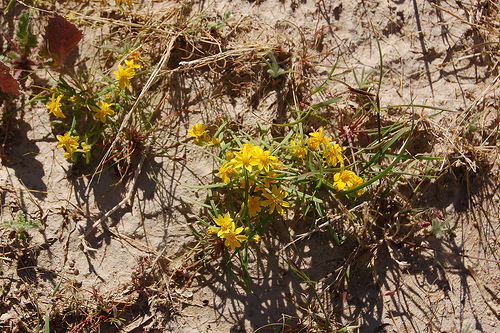
Fall wildflowers after summer rains (Photo by Larry Hogue).
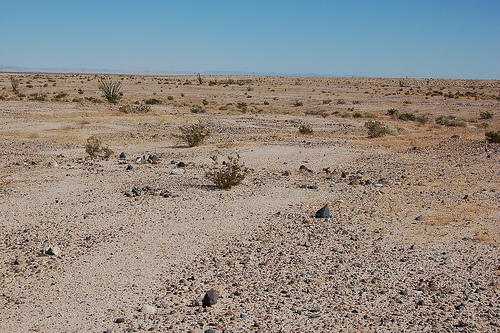
Arachaeological features (Photo by Larry Hogue).
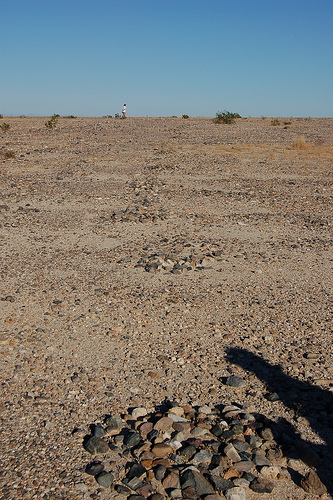
Row of ancient cairns (Photo by Larry Hogue).
^Archaeological "maze" with rock lines (Photo by Tom Budlong).
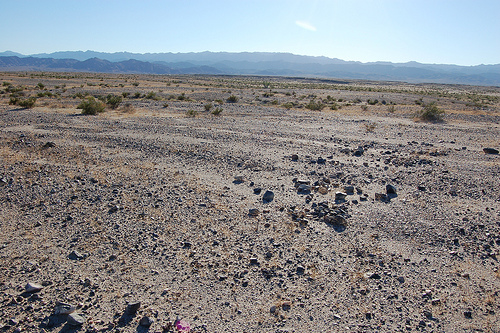
Cairns (Photo by Larry Hogue).
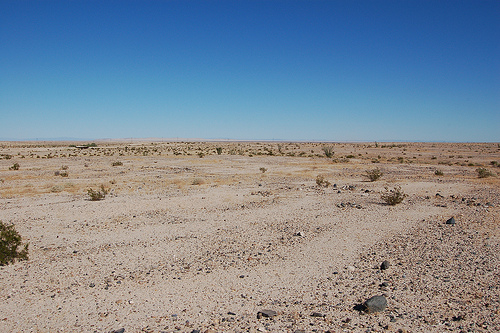
Archaeological feature on the desert pavement (Photo by Larry Hogue).
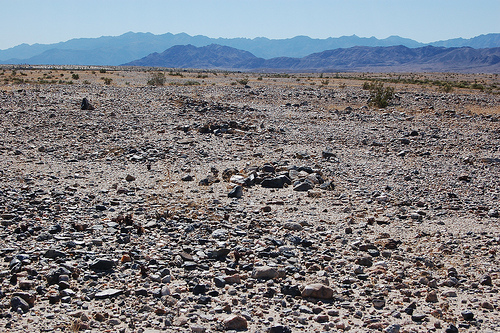
Row of cairns (Photo by Larry Hogue).
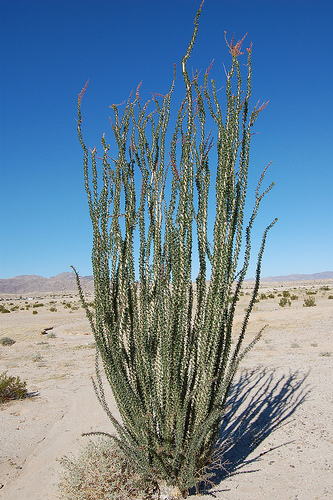
Ocotillo on the project site (Photo by Larry Hogue).

Indigo bush (Photo by Larry Hogue).

Old trail.
^Old trail across the desert pavement (Photo by Tom Budlong).
^Activist examines the old trail that will be obliterated by the solar project (Photo by Tom Budlong).
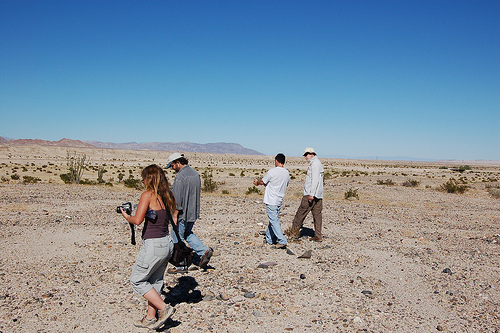
(Photo by Larry Hogue).
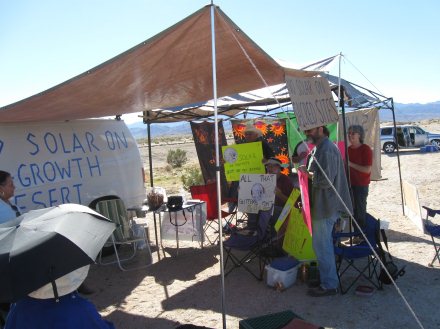
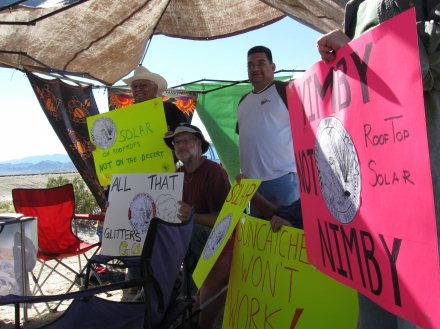
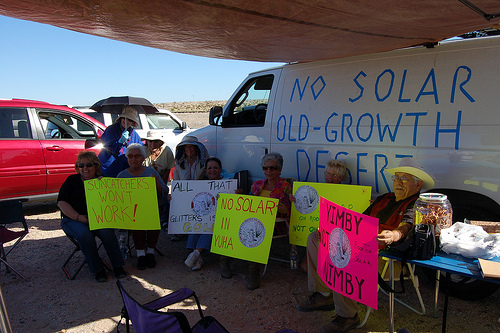
(Photo by Larry Hogue).
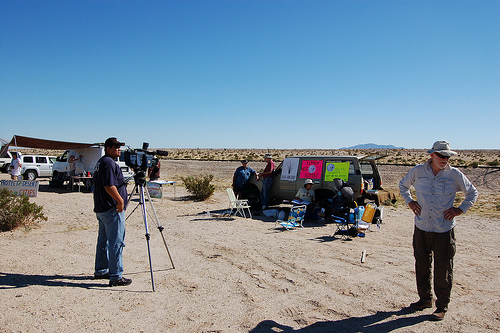
(Photo by Larry Hogue).

Protest a Success
November 16, 2010 - El Centro, California - Imperial Valley Solar Project site by Tessera Solar gets peaceful protest camp. Despite how this news article describes it, this camp attracted a large number of people over three days, including locals from El Centro, Ocotillo, Calexico, and Mexico. People saw with their own eyes the incredibly rich and ancient cultural sites, including more geoglyphs.
http://www.ivpressonline.com/news/ivp-news-planned-solar-field-protesters-20101116,0,7591995.story
Join in Peaceful Protest at Site
November 11, 2010 - Opponents of Desert Solar To Gather At Imperial Solar Two Site November 15.
A coalition of citizen activists will gather in Ocotillo, CA on Monday and Tuesday, November 15-16, to oppose the Tessera Imperial Solar Two solar project and support a lawsuit against the project by the Quechan Tribe.
The protest gathering, a peaceful, legal encampment on public lands, will begin Monday Nov. 15 at 11 am, along the Evan Hewes Highway opposite Painted Gorge Road, four miles east of Ocotillo. (Note: this location is three miles west of the one mentioned in a previous press advisory.)
The California Energy Commission approved the Imperial Solar Two project in September and the Department of the Interior (DOI) issued its Record of Decision approving the project in mid-October. The Quechan filed suit against the DOI in San Diego District Court October 29.
Construction of the project would involve bulldozing 6,000 acres of intact desert with immense habitat and cultural values, and installing 28,000 "Sun-Catchers." Sun Catchers consist of large parabolic mirrors that would track the sun and focus its heat on Stirling engines, which use the heat to power small, noisy turbines.
"This project is so large it will block a crucial connectivity corridor between two core populations of the flat-tailed horned lizard," said herpetologist Laura Cunningham, who has studied the local horned lizard population. "We need to preserve this desert habitat, not industrialize it."
The survival of the flat-tailed horned lizard is a key issue in the lawsuit by the Quechan, who hold the lizard as sacred.
Tessera's Sun-Catcher technology has never been tested on an industrial scale. "Tessera is using 8 months experience with 60 SunCatchers in Phoenix to predict 40 years of successful operation of 80,000 Sun-Catchers at Imperial and Calico in California, and Colorado’s San Luis Valley," said Tom Budlong, an engineer who intervened in the Imperial project with the California Energy Commission. "Only the federal government has agreed to take this risk. Private investors have not."
The construction of the project's 28,000 Sun-Catchers will cause un-mitigable impacts to habitat connectivity for the flat-tailed horned lizard, destroy foraging habitat for desert bighorn sheep, and grievously harm air quality by scraping 6,000 acres of desert surface. The Environmental Protection Agency has already placed Imperial County's air quality in "severe non-attainment" status due to its high particulate matter content. The project area is crisscrossed by washes of critical ecological importance. As importantly, the project will also destroy cultural and biological resources of significance within the traditional territory of the Quechan Indian Tribe.
Engineers, biologists and representatives of the Quechan Tribe will be available for press inquiry at the encampment.
Quechan Tribe Sues to Halt Project
November 3, 2010 - The Quechan Tribe of the Fort Yuma Indian Reservation asked the court for an injunction of the Imperial Valley Solar Project, directed at the Department of Interior and Bureau of Land Management.
"For thousands of years, the Quechan Tribe and tribal ancestors traditionally occupied, traveled, traded, and utilized resources within a broad geographical area located within the desert lands of modern-day Arizona and Southern California," they said in their brief made public today.
The Tribe says many culturally senstive resources are located on the project site, and Interior has failed to address the Tribes comments or consider many sites for the National Historic Preservation Act.
"The Tribe's interest in this action is not limited to cultural resources. The Tribe and its members also have an interest in preserving the quality of the land, water, air, fauna, and flora within the Tribe's traditional territory, within and outside the Reservation. Specifically, the Tribe is concerned with impacts to the habitat of Flat Tailed Horned Lizards on lands proposed for development, as the lizard is a central part of the Tribe's creation story."
http://www.signonsandiego.com/news/2010/nov/02/indian-tribe-files-suit-to-stop-solar-project/
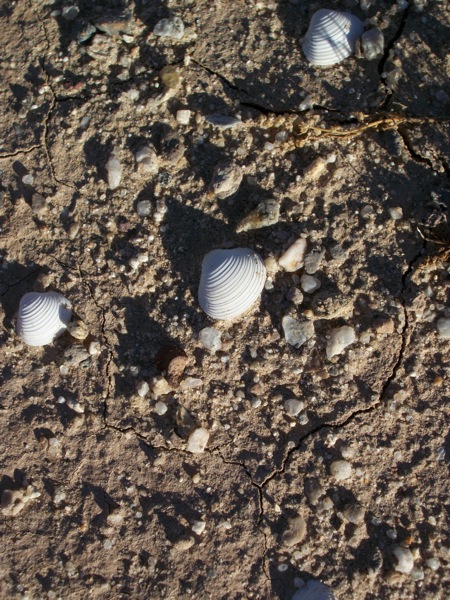
^Shells on the project site.

^Honeysweet (Tidestromia oblongifolia).
Imperial Valley Solar Project Approved by Secretary Salazar and Governor
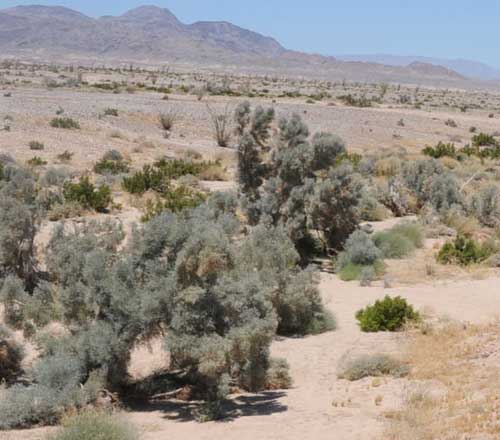
^Smoke tree wash will be obliterated by 40-foot high Stirling dishes.
October 5, 2010 - At 11:00 AM this morning, Interior Secretary Ken Salazar, overseeing the Bureau of Land Management land where the project is located, signed the final Record of Decision approval of the massive Stirling dish project along with California Governor Arnold Schwarzenegger. The project will scrape ten square miles of habitat for Flat-tailed horned lizard, Burrowing owls, Pensinsular bighorn sheep, and rare plants. Hundreds of cultural sites will be destroyed.
“Our collaborative approach shows how separate government processes can be streamlined, without cutting any corners or skipping any environmental checks and balances in the process,” Salazar said. “I commend Governor Schwarzenegger and the people of California for their leadership and partnership on these important renewable energy projects."
http://www.whitehouse.gov/blog/2010/10/05/first-large-scale-solar-energy-plants-public-lands
http://www.signonsandiego.com/news/2010/oct/05/feds-approve-big-imperial-valley-solar-project/
http://phoenix.bizjournals.com/phoenix/stories/2010/10/04/daily19.html
Energy Commission Licenses Imperial Valley Solar Project
September 29, 2010 - The five Commissioners voted to approve the project in western Imperial County today, adopting the Presiding Member's Proposed Decision. The project still needs a Right-of-Way from Bureau of Land Management.
"No surprise here, but still tragic when one considers the un-mitigable impacts to habitat connectivity for the flat-tailed horned lizard, destruction of foraging habitat for the bighorn sheep, the air quality impacts from scraping 6,000 acres of desert, the air pollution impacts an air basin that is in severe non-attainment for particulates, impacts to a sole source aquifer, and the utter destruction of native American cultural landscape adjacent to the Yuha Aarea of Critical Environmental Concern. This area of Western Imperial County, in the California Desert Conservation Act Plan, prior to the plan amendment for this project, was heretofore an Open Space Preservation Zone," said Terry Weiner of the Desert Protective Council.
The public made comments today in a final plea on behalf of the natural resources and cultural landscape that we are about to lose forever to 30,000 or more SunCatchers on a project that may or may not provide be able to produce the 705 MW and will probably be decommissioned in a few decades.
The California Eenergy Commission stated that all of this important input on various destructive impacts of this project helped them to "make this a stronger project and a stronger decision."
Energy Commission Approves 959 MW of Solar Power in California Desert
SACRAMENTO - Following the recent success of licensing solar energy facilities, the California Energy Commission today approved nearly 1,000 megawatts (MW) of solar power in Southern California.
The Genesis Solar Energy Project and the Imperial Valley Solar Project, totaling 959 MW, are now the fifth and sixth solar power plants that the Energy Commission has licensed in the past five weeks. Since late August, the Commission has licensed 2,829 MW of renewable solar power in the California desert.
"These approved solar projects continue to demonstrate the importance of harnessing the power of the sun for clean, renewable energy for California's communities," said Energy Commission Chairman Karen
Douglas. "By adding nearly 1,000 megawatts of renewable power we will reduce the consumption of fossil fuels and get the State closer to its goals of using more renewables by 2020. Today's actions show how California is leading the nation by licensing nearly 3,000 megawatts this year with large-scale solar power plants," Douglas added.
In two separate unanimous votes, the Energy Commission adopted the presiding member's proposed decisions (PMPD) that recommended licensing the 250-MW Genesis project in Riverside County and the 709-MW Imperial Valley project in Imperial County. In order to qualify for federal stimulus funds, the projects needed to be approved by the Energy Commission before December 31, 2010.
These projects are a direct result of the successful partnership between California and the Department of the Interior (DOI). In October 2009, California was the first state to sign a memo of understanding with the DOI to develop long-term renewable energy plans through state and federal permitting processes that can receive 30 percent federal tax credits under the American Reinvestment and Recovery Act. The two projects would be among the first commercial solar thermal power plants permitted on federal public land in the United States. Both projects still require decisions from the Bureau of Land Management (BLM), which approves the use of federal public lands, before they can proceed. The BLM's actions are scheduled for October.
The Genesis Solar Energy Project is being proposed by Genesis Solar LLC, a subsidiary of NextEra Energy Resources, LLC. The project site is located in eastern Riverside County about 25 miles west of Blythe. The project is north of Ford Dry Lake and Interstate 10. The project is seeking a right-of-way grant from the BLM for 4,640 acres, with construction and operation of the facility taking up about 1,800 acres.
The proposed project would use parabolic trough technology where parabolic mirrors are used to heat a transfer fluid which is then used to generate steam. Electricity is produced from the steam expanding
through steam turbine generators.
The Imperial Valley Solar Project is being developed by Imperial Valley Solar, LLC, a subsidiary of Tessera Solar, in Imperial County. The project is located about 14 miles west of El Centro.
The project would be located on approximately 6,140 acres of land managed by the BLM and about 360 acres of privately-owned land.
The facility would use solar dish Stirling systems, or "SunCatchers", consisting of a solar receiver heat exchanger and a closed-cycle, high efficiency engine designed to convert solar power to rotary power, then driving an electrical generator to produce electricity.
The Genesis and Imperial Valley projects are among nine large solar thermal projects scheduled to go before the Commission before the end of the year. More than 4,100 megawatts of solar power will be added if all nine projects are approved. The nine projects would provide more than 8,000 construction jobs and more than 1,000 operational jobs.
The four previously licensed plants are: the 250-MW Beacon Solar Energy Project (Aug. 25); the 250-MW Abengoa Mojave Solar Project (Sept. 8); the 1,000-MW Blythe Solar Power Project (Sept. 15); and the 370-MW Ivanpah Solar Electric Generating System project (Sept. 22). The 663.5-MW Calico Solar Project is scheduled for the Oct. 28 meeting. Two other projects, the 500-MW Palen Solar Power Project and the 150-MW Rice Solar Energy Project, are still under review.
The PMPDs for the Genesis and Imperial Valley projects said the facilities, even with mitigation measures, will have significant impacts on cultural resources, land use, and visual resources. The Imperial Valley project also will have significant impact on biological resources and would be inconsistent with an Imperial County land use ordinance.
However, the benefits of the projects would override those impacts. The Genesis project will require a peak workforce of 1,085 during construction, with another 50 jobs when the plant is in operation. The
Imperial Valley project will need a peak workforce of 731 during construction, with another 164 operational jobs.
The PMPDs were based solely on the record of facts that were established during the facilities' certification proceedings.
The proposed solar thermal power projects that the Energy Commission is considering will help meet the state's Renewables Portfolio Standard, which requires California's electricity utility companies to use
renewable energy to produce 20 percent of their power by 2010 and 33 percent by 2020. Solar energy is a main source of renewable power.
The federal government and the State of California have established the need to increase the development and use of renewable energy in order to enhance the nation's energy independence, meet environmental goals, and create new economic growth opportunities.
Genesis Solar Project:
http://www.energy.ca.gov/sitingcases/genesis_solar/
Imperial Valley Solar Project:
http://www.energy.ca.gov/sitingcases/solartwo/
Swedish Public Radio Story
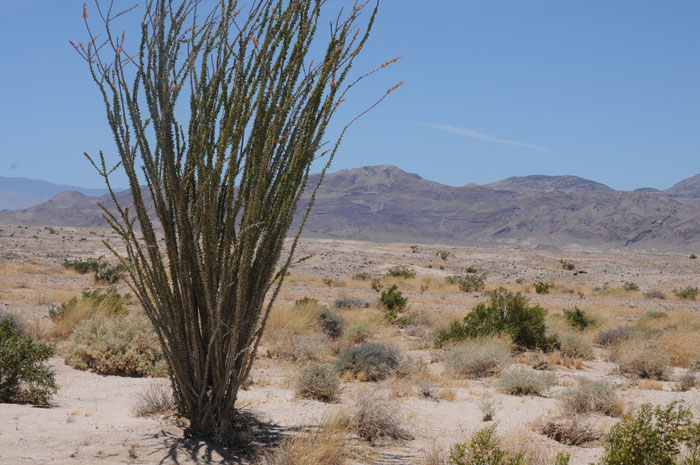
September 8, 2010 - Claes Andreasan of Swedish Public Radio came to the Imperial Valley Solar Project site recently to interview local activists.
See http://www.swedishpublicradio.com/solarpower.htm
Tessera Pulls Out of Texas Project

September 2, 2010 - San Antonio, Texas - Tessera Solar pulled out of their San Antonio contract. We hope it might have been because the local community pushed them to do sound, light studies and 3-d visualization of the site, causing them to fall behind on their timeline, losing their Department of Energy subsidy money.
The San Antonio utility CPS Energy's goal of obtaining 100 megawatts of solar power took a hit Wednesday when it learned the company contracted to sell it 27 megawatts from West Texas withdrew from the agreement. Tessera Solar was unable to obtain financing and has put on hold plans to build the project near Marfa. The plant was supposed to break ground this summer.
“The project is not dead, but the purchase power agreement is no longer in place,” Tessera spokeswoman Janette Coates said.
CPS never disclosed the cost of the solar contract, but chief sustainability officer Cris Eugster said replacing the megawatts with a different solar project could be cheaper.
“We've got a lot of momentum,” Eugster said. “This opens the possibility to do 27 megawatts in San Antonio instead of West Texas.”
When CPS signed the 20-year agreement to purchase Tessera's power in June 2009, it was the utility's first purchase of solar energy. Its 100-megawatt solar goal is part of a larger effort to secure 1,500 megawatts of renewable energy capacity by 2020. CPS already has agreements in place for 850 megawatts of wind power, Eugster said. Two months after the Tessera announcement, the utility inked a deal to buy all 14 megawatts to be generated by Blue Wing, a ground-mounted solar farm in southern Bexar County that has just begun producing power.
Ten megawatts of solar will be produced by the utility's new Solartricity producer program, which flips the traditional energy model on its head. Participants in the two-year pilot program will install roof-mounted solar photovoltaic systems, then sell the power they generate to CPS, which will pay 27 cents a kilowatt hour.
http://www.mysanantonio.com/news/cps_loses_a_solar_provider_102017078.html
Proposed Decision Recommends License For Imperial Valley Solar Project
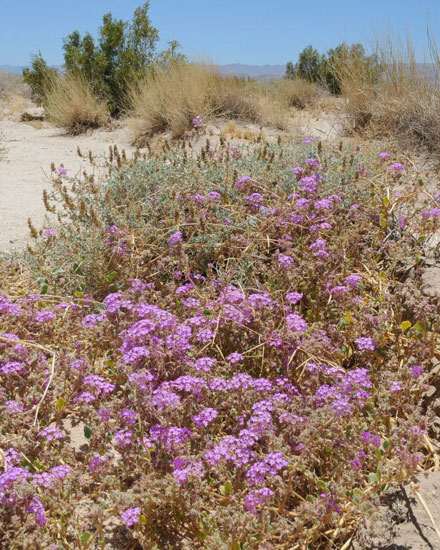 August 26, 2010 - Sacramento - A California Energy Commission siting committee is recommending approval of the planned Imperial Valley Solar Project in Imperial County.
August 26, 2010 - Sacramento - A California Energy Commission siting committee is recommending approval of the planned Imperial Valley Solar Project in Imperial County.
In its presiding member's proposed decision (PMPD) released today, the committee adopted the proposed 709-megawatt project alternative preferred by the federal Bureau of Land Management. The project, even with mitigation measures, will have significant environmental impacts to biological resources, cultural resources, land use, and visual resources. The project will also be inconsistent with a land use provision in the Imperial Valley General Plan. However, the benefits of the project would override those impacts. In addition, the committee determined that the project complies with all other applicable laws, ordinances, regulations, and standards.
Over the past month, the Energy Commission has issued proposed decisions recommending the approval of more than 2,800 megawatts of solar power, including the Imperial Valley Solar Project. The other projects that are recommended to be considered for a license to construct are the 250 MW Abengoa Mojave Solar Project; the 250 MW Beacon Solar Energy Project; the 1,000 MW Blythe Solar Power Project; the 250 MW Genesis Solar Energy Project; and the 370 MW Ivanpah Solar Electric Generating System Project.
On Wednesday, the full five-member Commission unanimously approved the Beacon Solar Energy Project, the first solar thermal power plant permitted in 20 years.
The proposed decision for the Imperial Valley Solar Project was based solely on the record of facts, which were established during the facility's certification proceeding.
The PMPD is /not/ a final decision on the project. The committee released the document for 30 days of public comment and will consider input before bringing the proposed decision to the full five-member
Commission. The entire document can be found on the Commission's website at: http://www.energy.ca.gov/sitingcases/solartwo/documents/index.html
The Imperial Valley Solar Project is being developed by Imperial Valley Solar, LLC in Imperial County, California largely on public land managed by the federal Bureau of Land Management. The project site is located approximately 14 miles west of El Centro.
The primary equipment for the generating facility would include approximately 28,000 25-kilowatt solar dish Stirling systems, or "SunCatchers", consisting of a solar receiver heat exchanger and a closed-cycle, high efficiency engine designed to convert solar power to rotary power, then driving an electrical generator to produce electricity.
The federal government and the State of California have established the need to increase the development and use of renewable energy in order to enhance the nation's energy independence, meet environmental goals, and create new economic growth opportunities.
For more information on Governor Arnold Schwarzenegger's Executive Order to advance the state's Renewables Portfolio Standard, go to: http://gov.ca.gov/press-release/13273
More information on the Imperial Valley Solar Project is available at:
http://www.energy.ca.gov/sitingcases/solartwo/index.html
Cultural Resources "Extraordinary" at Imperial
August 16, 2010 - Final Evidentiary Hearing, California Energy Commission, Sacramento, California - At the Imperial Valley Solar Project site, cultural resources are very dense, including lithic artifacts, ceramic pieces, prehistoric camps, ancient trails, cairns, agave roasting pits, geoglyphs, sleeping circles, ancient trails, lithic workshops, fire pits, ceramics, a "village," shell middens, geoglyphs, and a metate fragment, according the CEC Staff Assessment/Bureau of Land Management Draft Environmental Impact Statement. Cremation sites of concern to Native Americans would also potentially be disturbed by the placement of 40-foot tall SunCatcher dishes.
Not only these archaeological materials, but tribes in the area have sacred sites, viewscapes, sacred mountains, all in an interconnected network of a large sacred geography. Ethnographic reports have been neglected in this area.
The Yuha Desert just to the south has a very old dance circle, intaglios, and more old trails. Tribes have issues with the giant 6,000-acre SunCatcher project producing glint and glare on views to certain sacred mountains, such as the Coyote Mountains and Signal Mountain in the area. The entire landscape could be considered sacred. This is not being considered by the California Energy Commission nor Bureau of Land Management in the headlong rush to approve the solar project.
This area was on the old shoreline (750 to 250 years ago) of a large prehistoric lake, Lake Cahuilla, and thus is littered with artifacts, very densely.
Fragile human remains on the project site should be completely avoided, the Tribes say (Quechan, Cocopah, and Kwaaymii), but the only choice offered them has been to cover the cremation sites with a cement cap.
Cultural experts for the CEC revealed that the Imperial Valley site has the most cultural and archaeological resources of any of the several large solar projects proposed for the California Desert, the second being the Calico Solar Project with half the density of artifacts and features. In fact, the CEC expert gave testimony at today's hearing that the Imperial site is so dense with cultural material it surpasses in amount all other CEC cases to date. Stated another way, the density of cultural sites on this site is more than all CEC cases combined in the last 30 years.
"We are used to dealing with 20 to 80-acre gas-fired plants, with a very small amount of resources," said the expert. He called the frequency of cultural artifacts per acre here "extraordinary."
Preston Arrowweed, Quechan elder and tribal singer made a public comment after this day-long discussion, telling a creation story from his people that centered around the project site, mentioning the various hills by name around the area.
He was amazed a project would be placed on cremation sites, saying how when he walked out there he felt the presence of people. The archaeologists knew nothing about what was going on out there: "You talk about cremations and you don't know anything about it. Your PhD's have not gone to our universities!" The CEC had given the tribes the option of having the cremation sites capped with cement.
He said their religious views and rights were being lost in all the scientific language, the technical language, the government language. "Why do you want projects on all our cultural sites all the time? You want to destroy everything before you know what's there. I thought science wanted to know about these things."
BLM's Final Environmental Statement Out
July 28, 2010 - In the Federal Register, Notice of Availability of the Final Environmental Impact
Statement for the Imperial Valley Solar, LLC Project, California and the Proposed California Desert Conservation Area Plan Amendment, from the Bureau of Land Management.
DATES: The BLM planning regulations state that any person who meets the conditions described in the regulations may protest the BLM's ProposeRMP Amendment. A person who meets the conditions must file the protest within 30 days after the date the Environmental Protection Agency publishes its notice of availability in the Federal Register. The BLM will also be accepting additional public comments on the RMP/EIS within 30 days after the date that the Environmental Protection Agency publishes its Notice of Availibility in the Federal Register. Comments can be sent to Jim Stobaugh at the addresses given below. All substantive comments will be reviewed and responded to in the Record of Decision.
ADDRESSES: Copies of the Proposed RMP Amendment/Final EIS are available for public inspection at the El Centro Field Office, 1661 S. 4th Street, El Centro, California 92243. Interested persons may also review the Proposed RMP Amendment/Final EIS on the following Web site: http://www.blm.gov/ca/st/en/fo/elcentro/nepa/stirling.html. All protests must be in writing and mailed to one of the following addresses:
------------------------------------------------------------------------
Regular mail Overnight mail
------------------------------------------------------------------------
BLM Director (210), Attention: Brenda BLM Director (210),
Williams, P.O. Box 66538, Washington, DC Attention: Brenda Williams,
20035. 1620 L Street, NW., Suite 1075, Washington, DC 20036.
------------------------------------------------------------------------
All comments must be in writing and sent to Jim Stobaugh, BLM Project Manager, by mail at Bureau of Land Management, P.O. Box 12000, Reno, Nevada 89520; or by e-mail at Jim_Stobaugh@blm.gov.
FOR FURTHER INFORMATION CONTACT: Jim Stobaugh, BLM Project Manager, by telephone at (775) 861-6478; through mail at Bureau of Land Management, P.O. Box 12000, Reno, Nevada 89520; or by e-mail at Jim_Stobaugh@blm.gov.
SUPPLEMENTARY INFORMATION: Stirling Energy Systems (SES) filed right- of-way (ROW) application CACA-47740 for the SES Solar Two Project. Afrter merging with Tessera Soar the applicant changed its name to Imperial Valley Solar, LLC. The project name, SES Solar Two, has also been changed to the Imperial Valley Solar, LLC project. The proposed IVS Project is a concentrated solar electrical generating facility capable of generating 709 megawatts (MW) of renewable power. The entire project encompasses approximately 6,144 acres of BLM-managed lands. The project site is in Imperial County, California, approximately 4 miles east of Ocotillo and 14 miles west of El Centro. Generally, the site is bounded on the north by the San Diego Metropolitan Transit System/San Diego and Arizona Eastern Railway and on the south by Interstate Highway 8. The eastern boundary is approximately 1.5 miles west of Dunaway Road and the western boundary is the westerly section line in Section 22 in Township 16 South, Range 12 East. An additional 110-acre laydown construction area is proposed east of Dunaway Road.
IVS proposes to use SunCatcher technology on the site. A SunCatcher is a 25-kilowatt solar dish designed to automatically track the sun and collect and focus solar energy onto a power conversion unit (PCU), which generates electricity. The system consists of a 38-foot high by 40-foot wide solar concentrator in a dish structure that supports an array of curved glass mirror facets. These mirrors concentrate solar energy onto the solar receiver of the PCU.
The project also includes an electrical transmission line, water supply pipeline, and access road. A new 230-kilovolt (kV) substation would be constructed in approximately the center of the project site near a main services complex that is also part of the proposal. The substation would be connected to the existing San Diego Gas and Electric Imperial Valley Substation by a 10.3-mile long, double-circuit
230-kV transmission line. Approximately 7.6 miles of this new line would be outside the project area, but is included in the analysis. The transmission line would occupy approximately 92 acres.
The BLM has entered into a MOU with the California Energy Commission (CEC) to conduct a joint environmental review of solar thermal projects that are proposed on Federal land managed by the BLM,
with the CEC as the lead agency preparing the environmental documents. The BLM and CEC have agreed through the MOU to conduct the review of the IVS Project in a single combined NEPA/California Environmental Quality Act process and document.
The Notice of Intent to Prepare an EIS/Staff Assessment and Proposed Land Use Plan Amendment for the Proposed Imperial Valley Solar Project in Imperial County, California was published on October 17,
2008 (see 73 FR 61902). The BLM held two public scoping meetings in El Centro, California, on November 24 and December 18, 2008. The formal scoping period ended January 2, 2010. The BLM invited the National Park Service to enter a Memorandum of Understanding (MOU), as a cooperating agency in the EIS, for its special expertise concerning the Juan Batista de Anza National Historic Trail.
In addition, the BLM and the U.S. Army Corps of Engineers (Corps) entered into an MOU to formalize the Corps as a Federal cooperating agency in developing the Final EIS. The Corps' requirements under the
Clean Water Act (CWA), Section 404(b)(1) Guidelines are to identify and authorize only the Least Environmentally Damaging Practicable Alternative which maximizes avoidance and minimizes impacts to aquatic resources of the United States. The Corps and the applicant are working with the BLM and CEC to identify the project proposal that would reasonably comply with the Corps' requirements under the CWA and 404(b)(1) Guidelines.
The Notice of Availability of the Draft Environmental Impact Statement/Staff Assessment for the Stirling Energy Systems Solar Two Project and Possible California Desert Conservation Area Plan Amendment
was published in the Federal Register on February 22, 2010 (see 75 FR 7624). Comments on the Draft RMP Amendment/Draft EIS/Staff Assessment received from the public and internal BLM review were considered and incorporated, as appropriate, into the proposed plan amendment.
Public comments resulted in the addition of clarifying text, but did not significantly change the proposed land use plan decision.
The BLM's purpose and need for the Solar Two project EIS/SA is to respond to IVS LLC's application under Title V of FLPMA (43 U.S.C. 1761) for a ROW grant to construct, operate, and decommission a solar thermal facility on public lands in compliance with FLPMA, the BLM ROW regulations, and other applicable Federal laws.
The BLM will decide whether to approve, approve with modification, or deny a ROW grant to IVS, LLC for the proposed IVS project. The BLM will also consider amending the California Desert Conservation Area
(CDCA) Plan (1980, as amended) through this analysis. The CDCA Plan, while recognizing the potential compatibility of solar generation facilities on public lands, requires that all sites associated with
power generation or transmission not identified in that plan be considered through the BLM's land use plan amendment process. If the BLM decides to grant a ROW, the BLM would also amend the CDCA Plan.
In the Final EIS analysis, the BLM's proposed action is to authorize the IVS Project and approve a CDCA Plan amendment in response to the application received from IVS. In addition to analyzing the
proposed action, the BLM has analyzed the following alternatives: Authorize a smaller 300 MW alternative and amend the CDCA Plan; authorize the project as described in the Drainage Avoidance 1
alternative that may reduce impacts to primary water drainages of the United States and amend the CDCA Plan; and authorize the project as described in the more restrictive Drainage Avoidance 2
alternative that may substantially reduce impacts in eastern and western high flow water drainages of the United States and amend the CDCA Plan. As required under the California Environmental Quality Act
and NEPA, the EIS analyzes a No Action alternative that would not require a CDCA Plan amendment. The BLM has also analyzed a No Project alternative to deny the project, but amend the CDCA Plan to potentially allow other solar energy power generation projects on the project site. The BLM additionally has analyzed a No Project alternative to deny the project and amend the CDCA Plan to prohibit solar energy power generation projects on the project site. The BLM has taken into consideration the provisions of the Energy Policy Act of 2005 and Secretarial Orders 3283 Enhancing Renewable Energy Development on the Public Lands and 3285A1 Renewable Energy Development by the Department
of the Interior in responding to the IVS application.
The BLM evaluated the potential impacts of the proposed IVS Project in this EIS on air quality, biological resources, cultural resources, water resources, geological resources and hazards, land use, noise,
paleontological resources, public health, socioeconomics, soils, traffic and transportation, visual resources, and other resources.
Instructions for filing a protest with the Director of the BLM regarding the Proposed RMP Amendment may be found in the Final EIS "Dear Reader'' Letter and at 43 CFR 1610.5-2. Protests must be
received by the Director by the close of the protest period to be accepted as valid. Protests that are postmarked by the close of the protest period, but received by the Director after the close of the
protest period will only be accepted as valid if the protesting party also provides a faxed or e-mailed advance copy before the close of the protest period.
E-mailed and faxed protests will not be accepted as valid protests unless the protesting party also provides the original letter by either regular or overnight mail by the close of the protest period. Under
these conditions, the BLM will consider the e-mailed or faxed protest as an advance copy that will receive full consideration. If you wish to provide the BLM with such advance notification, please direct faxed protests to the attention of the BLM protest coordinator at (202) 912- 7212, and e-mails to Brenda_Hudgens-Williams@blm.gov.
All protests, including the follow-up letter to e-mails or faxes, must be in writing and mailed to the appropriate address, as set forth in the ADDRESSES section above.
Before including your phone number, e-mail address, or other personal identifying information in your protest, you should be aware that your entire protest--including your personal identifying information--may be made publicly available at any time. While you can ask us in your protest to withhold your personal identifying information from public review, we cannot guarantee that we will be able to do so.
Thomas Pogacnik,
Deputy State Director, Natural Resources.
Sand Storms Along Highway 8
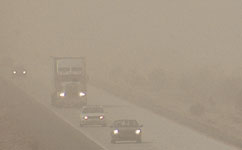
October 2007 - Interstate 8 was closed for over an hour early Friday afternoon from Dunaway Road to Ocotillo (next to the proposed Imperial Solar Project) and from Gordon's Well to Ogilby due to zero visibility from winds blowing sand and dust across the highway, according to the California Highway Patrol in El Centro. Today's (Saturday) National Weather Service forecast calls for sunny weather with less severe winds, between 10 and 16 mph, and gusts as high as 28 mph.
El Centro CHP spokesman Wes Boerner was urging motorists to stay off I-8 Friday if possible and said the interstate would continue to be patrolled. He said the road could be closed again if conditions worsened.
This raises questions about how much water will be needed for washing the dish mirrors to keep reflectivity optimal, as well as dust control once grading begins over thousands of acres. Much stronger chubasco winds come up suddenly from the southeast on occasion.
See video in the Yuma Sun.
BLM Releases its FEIS
July 28, 2010 - The Bureau of Land Managment released its Final Environmental Impact Statement for the Imperial Solar Project. Their process has been untethered from California Energy Commission proceedings, which issues its own environmental review document, as well as a seprate decision.
The BLM preferred alternative in the FEIS is identified as the 709 MW alternative. This alternative covers 6,476 acres, with slightly fewer SunCatchers (28,260). This alternative addresses issues identified by the Army Corps of Engineers related to water drainage and requirements of the Clean Water Act. Other changes address issues raised by the public and other agencies regarding impacts on the flat tailed horned lizard and cultural resources.
In addition to the protest period, the BLM will also be accepting public comment on the Final EIS for 30 days. Comments can be sent to Jim Stobaugh, National Project Manager, by mail: Bureau of Land Management, P.O. Box 12000, Reno, NV 89520-0006; or 1340 Financial Blvd, Reno, NV 89502; or email: caivspp@blm.gov
See:
http://www.blm.gov/ca/st/en/info/newsroom/2010/july/CDD85_imperial_valley_feis.html
More Hearings
MONDAY, July 26, 2010
Beginning at 10 a.m.
Public Comment period at 5:30 p.m.
and, if needed, on:
TUESDAY, July 27, 2010
Beginning at 9 a.m.
California Energy Commission
Hearing Room A
1516 Ninth Street
Sacramento, CA 95814
Basin and Range Watch will be covering these continued evidentiary hearings, which will pick up on topics covered in May. For more information see the CEC website.
Imperial Valley, Calico, and West Texas Projects
June 21, 2010 - SES/Tessera's 750-megawatt (MW) Imperial Valley Solar Project may be the first to break ground if permitted, closely followed by the West Texas Project, a 27-MW project with CPS Energy. Calico Solar Project is behind, near Barstow, California. It would be 850 MW. See Renewable Energy World.com
Evidentiary Hearings May 24-25, 2010
MONDAY, May 24, 2010
Beginning at 10:00 a.m.
Public Comment Period at 5:30 p.m.
and, if needed, on:
TUESDAY, May 25, 2010
Beginning at 9:00 a.m.
San Diego Gas & Electric Renewable Energy Resource Center
1425 West Main Street
El Centro, California 92243
TELECONFERENCE OPTION: The following toll free phone number will be available at 10: 00 a.m. on May 24 and 9:00 a.m. on May 25 for callers to participate in the hearing:
Call: 1-888-957-9863
Use Passcode: "IMPERIAL"
Conference Leader: "Raoul Renaud"
From California Energy Commission
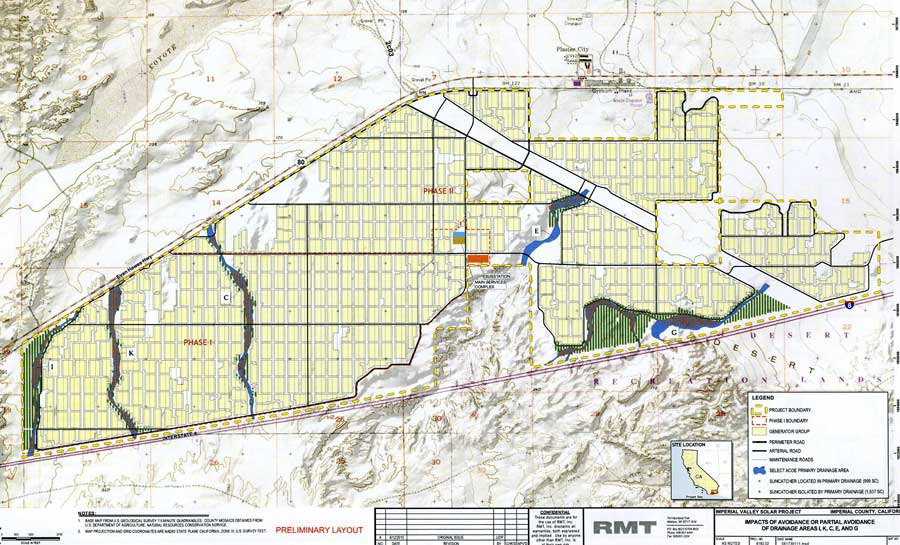
Tessera's test facility in Arizona:
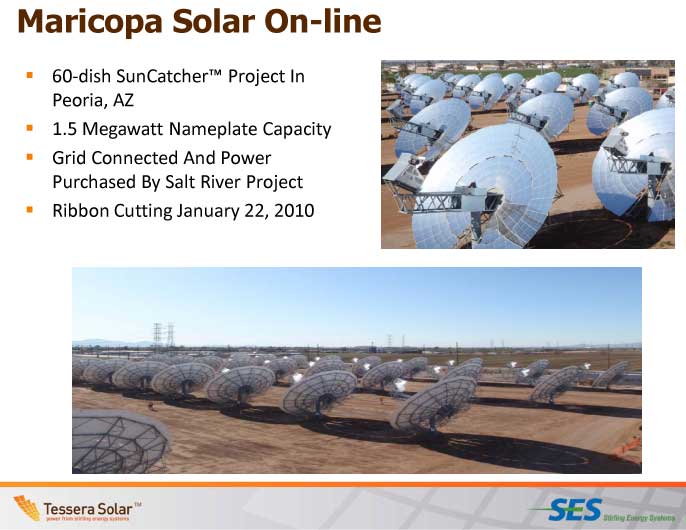
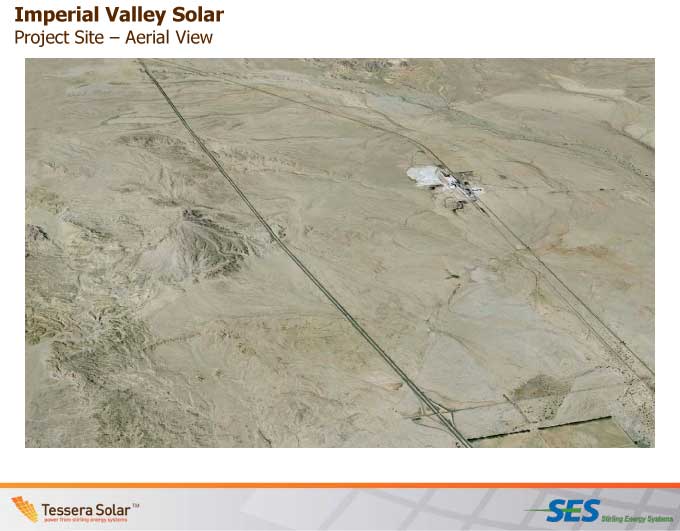
Site Visit: April Wildflowers
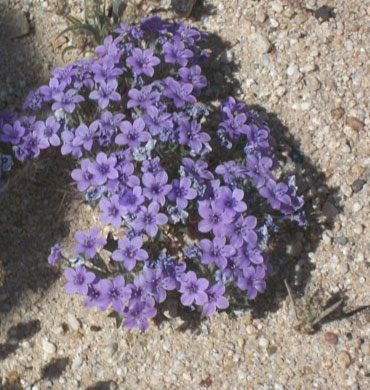
April 26, 2010 - See the excellent report of the visit to the Yuha Desert "Solar 2" project site by Chris Clarke on the Desert Blog, Desert Protective Council. Wildflowers were still out. More on our website of the same visit >>here.
DEIS Out - Comments Needed

^Flat-tailed horned lizard on West Mesa, near the project site.
February 22, 2010 - The Bureau of Land Management released its Notice of Availability of the Draft Environmental Impact Statement/Staff Assessment for the Tessera (formerly Stirling Energy Systems) Solar 2 Project (recently renamed Imperial) and Possible California Desert Conservation Area Plan Amendment. This opens the 90-day comment period.
The project would be similar to Tessera's Calico (Solar 1) north in the Mojave Desert east of Barstow (see our story >>here). Solar 2 in the Colorado Desert 14 miles west of El Centro in Imperial Copunty would produce 750 megawatts on approximately 6,144 acres of BLM-managed lands. Interstate 8 lies on the south.
SunCatcher 25-kilowatt solar dishes would be used, designed to automatically track the sun and collect and focus solar energy onto a power conversion unit (PCU), which generates electricity. The system consists of a 38-foot high by 40-foot wide solar concentrator in a dish structure that supports an array of curved glass mirror facets. These mirrors collect and concentrate solar energy onto the solar receiver of the PCU.
The area has many problems, being habitat for the Flat-tailed horned lizard (Phrynosoma mccallii), which in November 2010 is due for a decision on whether it should be listed as Federally Threatened under the Endangered Species Act. Many Tribes also have great concerns over cultural values they have on the site. Archaeology is dense here, as the area was on the shoreline of pluvial Lake Cahuilla.
The project also includes an electrical transmission line, water supply pipeline, and an access road. A new 230-kilovolt (kV) substation would be constructed in approximately the center of the project site near a main services complex that is also part of the proposal. The substation would be connected to the existing San Diego Gas and Electric Imperial Valley Substation by about a 10.3-mile long, double-circuit 230 kV transmission line.
The applicant has applied to the Department of Energy (DOE) for a loan guarantee under Title XVII of the Energy Policy Act of 2005, as amended by Section 406 of the American Recovery and Reinvestment Act of 2009, Public Law 111-5. Should the DOE decide to enter into negotiation of a possible loan guarantee with the applicant, the DOE would become a cooperating agency in developing the final EIS.
ADDRESSES: You may submit comments related to the SES Solar Two Project
by any of the following methods:
Web site: http://www.energy.ca.gov/sitingcases/solartwo/index.html.
E-mail: Cmeyer@energy.state.ca.us.
Fax: (818) 597-8001.
Mail or other delivery service: Christopher Meyer, Project Manager, Siting, Transmission and Environmental Protection Division, California Energy Commission, 1516 Ninth Street, MS-15, Sacramento, California, 95814.
Copies of the SES Solar Two Draft EIS/SA are available from the CEC
at the above address and in the BLM El Centro Field Office, 1661 S. 4th
Street, El Centro, California, 92243.
FOR FURTHER INFORMATION CONTACT: For further information contact Jim Stobaugh, BLM Project Manager, by telephone at (775) 861-6478 (775) 861-6478 ; through mail at Bureau of Land Management, P.O. Box 12000, Reno, Nevada 89520;
or by e-mail at Jim_Stobaugh@blm.gov.
California Energy Commission website >>here.
In the Federal Register: February 22, 2010 (Volume 75, Number 34), Notices, Page 7624-7625, wais.access.gpo.gov.
HOME.....Calico Solar Project (SES Solar 1).....Imperial Valley Earthquake
